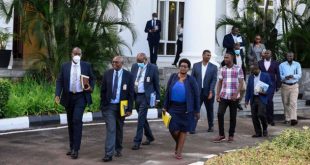
The Japanese engineering consultancy firm, Toyota Tsusho Corporation (TTC) had recommended Lamu in a 2014 feasibility study. TTC cited the economies of scale between Uganda and Kenya—both have discovered oil—and it also pointed at the benefits of $25 billion LAPSETT infrastructure corridor—that would connect the two to Ethiopia and South Sudan.
But French giant Total SA was opposed to the Lamu project from the start all. Their main argument was that Lamu port lies near the border with al-Shabaab terrorist infested Somalia. The port is also exposed to monsoon winds and studies had showed that the port has to be closed for four months every year when ships cannot dock there because of the winds. Since Uganda alone estimates to be pumping 230,000p/d to 250,000 b/d at peak production, with the port closed for four months, the companies would have to build a storage facility for 30 million barrels of oil for the four months for Uganda alone.
During negotiations the Kenyans had claimed that some preliminary works had been carried out on Lamu but when a Ugandan delegation visited, it found that nothing of the sort had happened—it turned out construction of the port itself was two years behind schedule. If Uganda opted for it, it would be looking at pumping oil in 2022.
Tanzania’s Tanga port on the other hand is already operational. On top of this, the Tanga route has existing roads with 1,101km of tarmac roads and 582km of usable murram roads, and a railway along the project right of way. Lamu route on the other hand, there was only a network of 183km of tarmac roads and 250km roads of usable murram roads but not fit for heavy trucks.
The Lamu was also hilly with steep slopes of above 25 degrees. The Tanga route, on the other hand was deemed flat with slopes of below 15 degrees at the most.
The Tanzania team argued that land acquisition would also not be a problem as land belongs to the government in Tanzania. Apart from this, there is no threat of terrorism or bad weather. The route would also be cheaper. The study by Toyota Tsutsho put the total cost of the Lamu route at US$5.1 billion but oil companies estimated it would cost even more. The Tanga route on the other hand required $3.55 billion.
Insider sources say President Museveni made a decision to go with the Tanga route on August 15, 2015.
Museveni and his technocrats had already been attracted to the Tanzania route because it offered a chance to diversify. 90 percent of Uganda’s imports and 80 percent of exports go through Mombasa, Kenya. Pushing the oil export pipeline through Kenya would have further concentrated the country’s assets in one basket.
Museveni was also swayed by lobbying and pitches in meetings with a team of experts from Texas-based firm Gulf Interstate Engineering (GIE), which had been contracted by French giant Total SA, the parent company of Total E&P, to do a feasibility study on the Tanga route.
According to sources, the most decisive of meetings with GIE was on Aug. 15. It is said that officials and experts spent hours poring over maps and analysing advantages and disadvantages of the different routes.
The GIE officials were also armed with studies of the other routes—one going through the Mombasa port of Kenya and another through the Lamu port of the same country.
It is around this time that Museveni is said to have picked the Tanzania route leading to the signing of the MoU with Tanzania two months later.
When the Kenyans saw this, they quickly returned to the drawing board and even put the Mombasa route on the table, which they had already cast in bad light while pushing for Lamu.
But it was too late, early in March last year, President Museveni met President Magufuli on the sidelines of the 17th Ordinary East African Community (EAC) summit and they confirmed the deal.
With the deal so close, President Magufuli took things a notch higher meeting the Total SA vice president for East Africa Javier Rielo and further agreeing on the deal.
In a meeting before the summit, President Museveni also met a delegation from Total led by the Africa director for exploration and production, Guy Maurice and the Uganda business general manager Adewale Fayemi. This was the clearest signal Total and Tanzania had taken the day.
Stubborn Tanzanians
However, although Uganda officially picked the Tanga pipeline route over one through Kenya in April 2016, the actual signing of the construction did not happen until May 2017.
The main reason behind the delay was that having lured Uganda with a package of six incentives, Ugandan officials say somehow along the way, “the Tanzanians became stubborn” and withdrew the incentives.
Owing to this, the deal had by November last year completely hit a snug. When The Independent talked to Permanent Secretary, Stephen Isabalija who was in the thick of negotiations to try and understand why the deal had faltered, he did not say much.
“All I can say is that we got it signed and will get others signed too,” he said.
He also confirmed that at one point he had to camp in Tanzania for an entire week at the height of the intractable negotiations.
Insiders say the deal rested solely on one man—President John Pombe Magufuli who was said to be suspicious of especially the oil companies and, being a nonsense president, he has no daring to advise or question him.
“People are terrified of being sacked,” an official told The Independent, “When you enter a meeting with Magufuli and there are government officials, they all either keep quiet or take one position.”
Magufuli also fired key officials who had been part of the negotiations like the Energy and Minerals minister Sospeter Muhongo and Permanent Secretary, Justin Ntaikwa. He had earlier also dropped Dr Servacius Likwelile as Finance permanent secretary and replaced him with Doto James. The new members to the negotiation table came with a different attitude, officials said.
During the discussion of the fiscal regime, the new Tanzanian team challenged the agreement that had been negotiated and said it was a proposal not an agreement.
Insider sources told The Independent that at one point, in a meeting, the Tanzania officials said “we don’t trust you oil companies” and told Ugandan officials “we have been too good to you; we have given you too many incentives”.
“We accepted to come through Tanzania because of this offer, so you are asking us to go back to Kenya,” Irene Muloni, the Energy Minister hit back. But her warning fell on deaf ears.
Tanzanian had apparently made an irresistible offer to Uganda—a package of six fiscal incentives. These included; VAT exemption during construction and operation on all goods and services. Under Ugandan law, VAT incurred during the investment phase was scrapped in 2015. But in Tanzania an investor is required to pay VAT and claim a refund later. Exempting the tax across the board would make things easier for the investors.
Apart from the VAT exemption, Tanzania had also offered that there would be no transit fees, there would be a tax holiday on incomes for ten years, 20% accelerated depreciation rate, reduced withholding tax rate on goods and services from 15 to 5%, exemption of 10% withholding tax on interest on loans. Under Tanzanian law, a borrower pays a 10% withholding tax on bank loan interest.
But in December 2016, the Tanzanian Finance Ministry wrote a letter noting that Tanzania would give Uganda only three out of the six incentives. It said the other three incentives were already in the Tanzanian law and did not need new approval of parliament.
 The Independent Uganda: You get the Truth we Pay the Price
The Independent Uganda: You get the Truth we Pay the Price



Let the hostee dream big like kenyatta with great